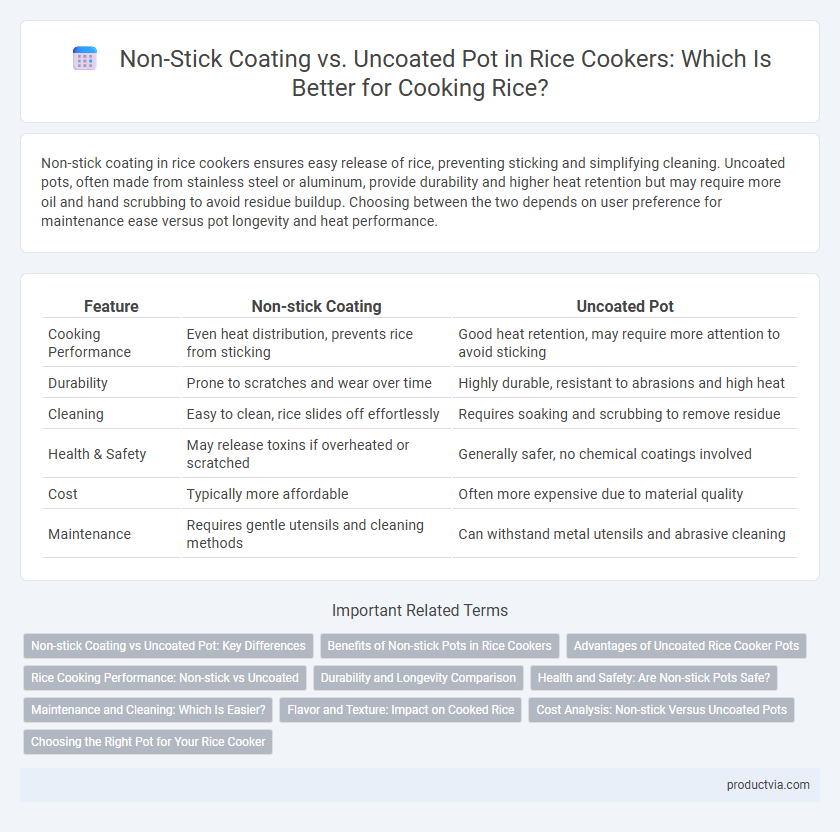Non-stick coating in rice cookers ensures easy release of rice, preventing sticking and simplifying cleaning. Uncoated pots, often made from stainless steel or aluminum, provide durability and higher heat retention but may require more oil and hand scrubbing to avoid residue buildup. Choosing between the two depends on user preference for maintenance ease versus pot longevity and heat performance.
Table of Comparison
| Feature | Non-stick Coating | Uncoated Pot |
|---|---|---|
| Cooking Performance | Even heat distribution, prevents rice from sticking | Good heat retention, may require more attention to avoid sticking |
| Durability | Prone to scratches and wear over time | Highly durable, resistant to abrasions and high heat |
| Cleaning | Easy to clean, rice slides off effortlessly | Requires soaking and scrubbing to remove residue |
| Health & Safety | May release toxins if overheated or scratched | Generally safer, no chemical coatings involved |
| Cost | Typically more affordable | Often more expensive due to material quality |
| Maintenance | Requires gentle utensils and cleaning methods | Can withstand metal utensils and abrasive cleaning |
Non-stick Coating vs Uncoated Pot: Key Differences
Non-stick coated rice cooker pots offer enhanced food release and easier cleaning compared to uncoated pots, which may require more oil to prevent sticking. Uncoated pots, often made from stainless steel or aluminum, provide greater durability and resist scratching but can cause rice to adhere if not properly maintained. The choice between non-stick and uncoated pots depends on cooking preferences, ease of maintenance, and longevity considerations.
Benefits of Non-stick Pots in Rice Cookers
Non-stick pots in rice cookers provide superior food release, preventing rice from sticking and burning, which ensures easy cleaning and preserves the texture of cooked rice. They reduce the need for excessive oil or butter, promoting healthier cooking and enhancing energy efficiency by enabling even heat distribution. The durability of non-stick coatings extends the lifespan of the pot, maintaining consistent performance and eliminating common issues associated with uncoated metal surfaces.
Advantages of Uncoated Rice Cooker Pots
Uncoated rice cooker pots offer superior durability and resist scratches better than non-stick coatings, making them ideal for long-term use with metal utensils. They provide safer cooking by eliminating the risk of toxic chemical release associated with damaged non-stick layers, ensuring healthier meal preparation. Additionally, uncoated pots often support higher temperatures and enhanced browning, giving rice dishes a richer texture and flavor profile.
Rice Cooking Performance: Non-stick vs Uncoated
Non-stick coated pots in rice cookers ensure even heat distribution and prevent rice grains from sticking, resulting in consistent texture and easy cleaning. Uncoated pots may require additional oil or water adjustments to avoid burning or uneven cooking, often leading to variable rice quality. Non-stick surfaces enhance cooking performance by maintaining moisture and preventing scorching, crucial for perfectly cooked rice every time.
Durability and Longevity Comparison
Non-stick coating rice cooker pots offer convenience with easy cleaning but may degrade over time due to scratches and high heat exposure, impacting durability. Uncoated stainless steel or aluminum pots tend to provide superior longevity as they resist chipping and wear, maintaining performance through extended use. Choosing an uncoated pot enhances the rice cooker's lifespan, making it a more durable option for heavy or frequent cooking.
Health and Safety: Are Non-stick Pots Safe?
Non-stick coatings in rice cookers typically use PTFE, which is considered safe at normal cooking temperatures but can release harmful fumes if overheated above 500degF (260degC). Uncoated pots, usually made from stainless steel or aluminum, do not risk chemical fumes but may require more oil to prevent sticking, affecting health considerations. Consumers prioritizing health safety should avoid overheating non-stick pots and consider uncoated alternatives to eliminate exposure to potential chemical coatings.
Maintenance and Cleaning: Which Is Easier?
Non-stick coating in rice cookers significantly simplifies maintenance and cleaning by preventing rice from adhering to the pot, allowing for quick and effortless washing with minimal scrubbing. Uncoated pots typically require soaking and more intensive cleaning to remove stuck-on rice and residue, increasing maintenance time and effort. Choosing a non-stick pot enhances overall convenience and prolongs the cooking device's lifespan through easier upkeep.
Flavor and Texture: Impact on Cooked Rice
Non-stick coating in rice cookers prevents rice from sticking and burning, preserving a softer texture and more consistent moisture distribution. Uncoated pots can produce a slightly firmer, nuttier rice with subtle browned crust spots that enhance flavor complexity. The choice between coatings influences the balance between ease of cleaning and the textural depth of cooked rice.
Cost Analysis: Non-stick Versus Uncoated Pots
Non-stick coated rice cooker pots generally cost 20-40% more than uncoated stainless steel or aluminum pots due to advanced materials and manufacturing processes. While non-stick surfaces reduce oil use and simplify cleaning, uncoated pots offer superior durability and longer lifespan, lowering replacement frequency and maintenance expenses. Consumers prioritizing initial affordability may prefer uncoated pots, whereas those valuing convenience and ease of use might invest in pricier non-stick cookware despite the higher upfront cost.
Choosing the Right Pot for Your Rice Cooker
Non-stick coated rice cooker pots offer easy food release and simple cleaning, reducing the risk of rice sticking and burning. Uncoated pots, often made from stainless steel or aluminum, provide durability and can withstand high temperatures without chemical coatings, appealing to health-conscious users. Selecting the right pot depends on balancing convenience, cooking performance, and material safety preferences specific to your rice cooker model.
Non-stick Coating vs Uncoated Pot for rice cookers Infographic

 productvia.com
productvia.com